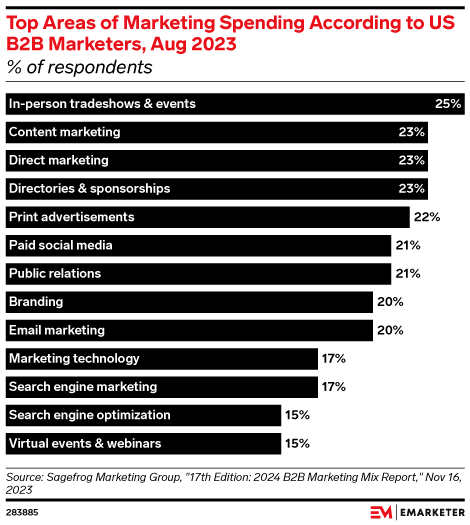Love online, wow in person
What's not to like?
One could easily dismiss the value of attending in-person events when so much is available online—insights, learning, connecting and building networks. Yet, if that is enough, why is the event industry thriving?
Screens dominate our daily interaction, bringing increasing benefits to life and work. Yet, as these technologies continue to improve, why does it feel like something “human” goes amiss?
Think back to the pandemic. Virtual communication flourished, yet the yearning to connect in person grew stronger the longer we were apart. Think of remote work. How often do people bemoan the absence of spontaneous “water cooler” moments?
Here’s how I see it.
The internet broadens our reach, but physical presence strengthens our bonds.
That, in a nutshell, is the case for in-person events.
IN-PERSON MATTERS:
Events create opportunities for connection that screen time cannot replicate. They engage, inspire, and build trust. The experiences are tactile and immediate. The abstract becomes tangible.
It is not surprising that the event sector rebounded powerfully post-pandemic, and continues to grow: According to Allied Market Research, the global events industry was valued at $1,135.4 billion in 2019 and is projected to reach $2,046.7 billion by 2032, with a CAGR of 6.4%.
In the B2B sector, in-person events remain critical to marketing plans. According to E-Marketer, Events-led Growth (ELG) addresses challenges “such as brand differentiation, engagement and lead nurturing.” Prioritising “audience-centric content and dynamic engagement fosters brand and community growth, which can boost revenues and customer retention.” Events, therefore, remain a top attraction for marketing spend:
Furthermore, events are critical in value creation. A Forrester survey of decision-makers highlights the importance of events and meetings in driving organisational priorities:
INGREDIENTS FOR SUCCESS:
There are many levers that event planners can use to ensure success (or, conversely, many things that can go wrong!). Here are some of the levers, including on-stage, off-stage and the blend of virtual and physical world initiatives.
On-stage:
As trust in institutions declines, we increasingly value individual’s expertise. Even better when we participate in live, unfiltered and authentic conversations. When programmers choose speakers solely for their names rather than their ideas (hint: often seen in programmes with panel upon panel on stage), it undermines audience value. A robust programme, therefore:
Features trusted, credible individuals relevant to the audience.
Offers fresh and inspirational insights that are difficult to find elsewhere.
Stimulates further off-stage conversation for audience value to grow exponentially.
Off-stage:
However, great events are far more than their speaker programmes. The real magic happens off-stage, where structured and spontaneous conversations amplify the value of shared ideas. Attendees may sign up for events because of compelling content, but time and again, they rate the connections and conversations made at the event as delivering the most enduring value.
Successful events create blended experiences. Besides the practical, they also address intrinsic needs like discovery, belonging and enjoyment. These events:
Are at their core audience-first – they respect their audience’s investment, time and needs.
Engage attendees on multiple levels – intellectually, socially, and emotionally.
Blend structure with flexibility to leave room for memorable conversations and lasting connections.
Leverage technology not for its own sake but to enhance and deepen the event experience.
Continuously evolve to keep events fresh, relevant, and rewarding for its audience.
Virtual and physical blend:
The internet and physical events exist in a powerful continuum that amplifies impact when thoughtfully integrated. Success lies not in choosing between channels but leveraging their complementary strengths throughout the event lifecycle.
It’s a bit like dating. Chatting online is great, but meeting in person is better.
Here are some examples of using digital to enhance the overall experience.
Pre-event:
Implement digital activities to prepare the groundwork for meaningful in-person connections. For example:
Community building and early networking opportunities
Content teasers and thought-provoking discussions
Pre-event participant surveys or interactive sessions
During the event:
Use technology to enhance (never compete with) face-to-face moments. For example:
Mobile solutions for seamless scheduling, connections and communication
Real-time feedback and dynamic event updates
Content capture for post-event sharing
Post-event:
Online platforms extend value and maintain momentum. For example:
Extending participant conversations
Sharing curated, valuable content
Building anticipation for the next event
When done right, online engagement amplifies the anticipation and impact of being there in person, while physical gatherings strengthen digital connections and create lasting communities.
The key is orchestrating elements so they flow naturally in the continuum, each reinforcing the other.
DYNAMIC and FUN:
I’d almost argue that events are the most real form of media. Each event consists of a host of dynamic elements, there is always room for innovation and improvement, and you get to spend time in the virtual and physical presence of your audience.
What’s not to like?
ABOUT THAT COALITION:
Amid rapid shifts in technology, consumer behaviour and market dynamics, organisations must cultivate efficiencies, agility and adaptability to compete.
That Coalition offers a fractional “Events-as-a-Service” model, where clients can tap into a coalition of independent event experts for help on their events. They can be coopted to manage complete projects or to complement in-house teams with certain functions. They can be coopted flexibly, across the entire event cycle or only in certain phases. Benefits of the model include:
Scaling services up or down as projects demand
Accessing specialised expertise only when needed
Avoiding one-size-fits-all solutions and pricing
Maintaining consistent quality while controlling expenses
In short, That Coalition helps clients with event services that:
Increase efficiency.
Drive quality.
Maximise value.
Follow That Coalition’s on LinkedIn: linkedin.com/company/thatcoalition/.
Contact me, Cobus Heyl, at cobus@thatcoalition.com or connect with me on LinkedIn (linkedin.com/in/cobusheyl/) for more.




